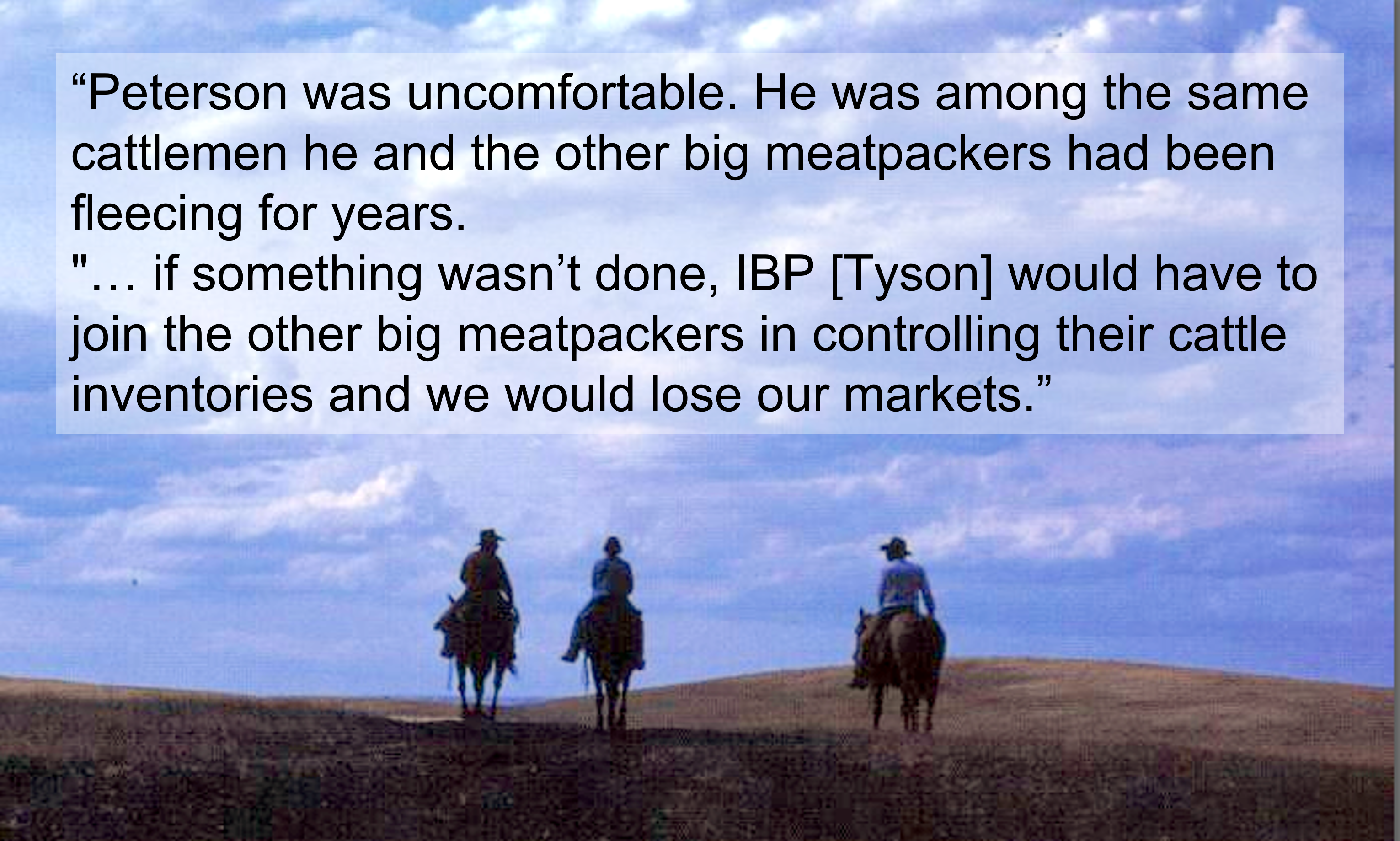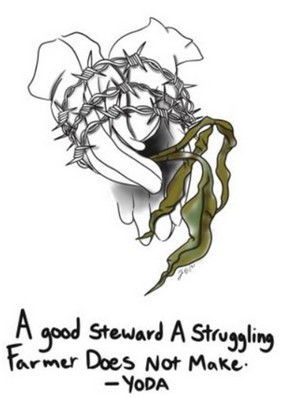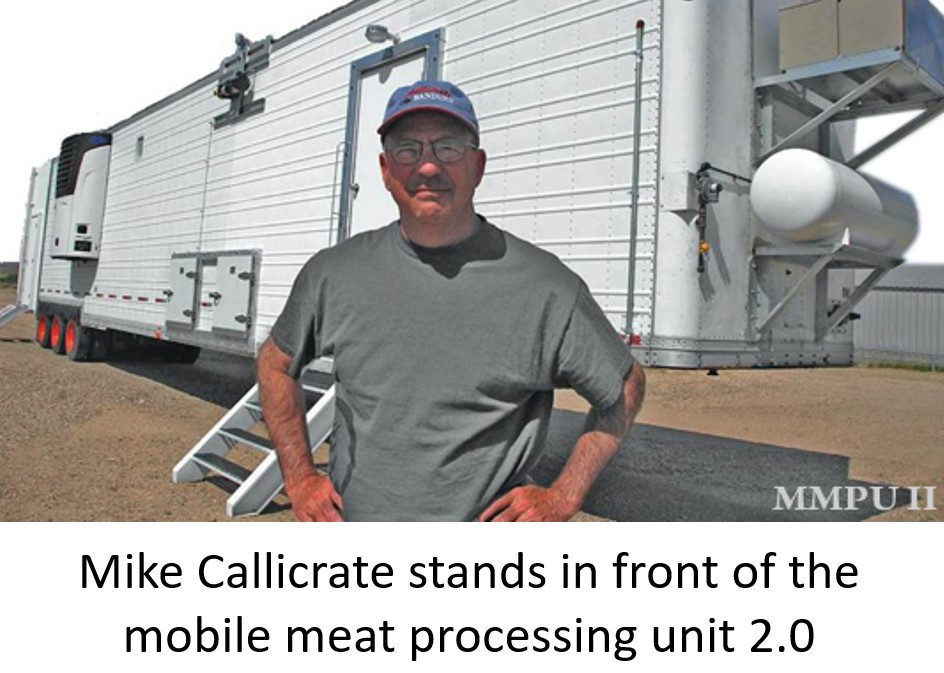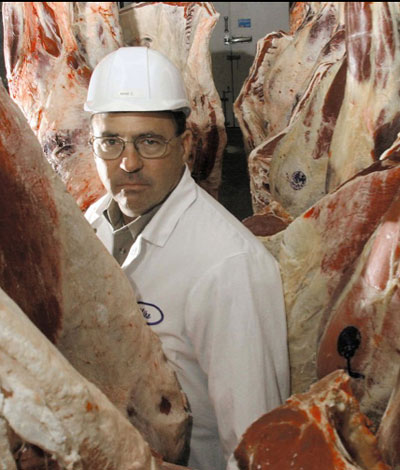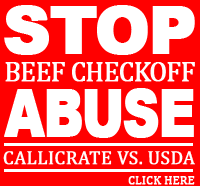“Changes will not simply happen…Changes will occur when consumers realize what they’ve been eating, get angry, and demand something different…It remains our responsibility, with every vote and every dollar spent on food, to start making it right.” (Eric Schlosser’s foreword from Slaughterhouse Blues.) Schlosser is also the author of Fast Food Nation and co-producer of the film that awakened America, Food, Inc.
It was a beautiful spring day in 1996. American’s were convinced that eating fat was bad. South Dakota Governor Bill Janklow was holding a beef conference in Pierre, South Dakota’s capital city. Robert Peterson, President, and CEO of our nation’s largest beef packer, IBP (now Tyson), made a rare appearance to inform cattlemen of IBP’s importance to them and the State of South Dakota. Peterson was uncomfortable. He was among the same cattlemen he and the other big meatpackers had been fleecing for years. Just two springs earlier, in the face of barbeque season and rising demand, IBP along with Cargill and ConAgra had stunned cattlemen by reducing live cattle prices a devastating $17 per cwt. (over $200 per head) in just a few weeks.
The last time I had heard Peterson speak was several years earlier at a Kansas gathering. He was warning cattle producers of the dangers to the marketplace if big packers owned cattle. He was talking about his big competitors, Cargill and ConAgra (now JBS), who were controlling large numbers of cattle at the time. He said these “captive supplies” of cattle disadvantaged IBP and if something wasn’t done, IBP would have to join the other big meatpackers in controlling their cattle inventories and we would lose our markets. He was right. Obama promised cattlemen a ban on meatpacker ownership in his 2008 campaign – he caved under pressure, giving big meatpackers permission to continue their unfair trade practices.

A Beef Products Inc. processing plant in South Sioux City, Neb. The company injects fatty beef trimmings with ammonia to remove E. coli and salmonella.
In Pierre, Peterson boasted about a new technology that could extract 11 percent lean meat from pure white fat. He explained how science and innovations, like this money-making technology, were an example of how big industry, executing with military-like efficiency and organization, could increase meat packers’ income, and in turn, he suggested, make the lives of cattle producers better. The technology he was referring to was one of the Advanced Meat Recovery (AMR) inventions of Eldon Roth, owner of BPI (Beef Products Inc.).
Peterson also reminded the large gathering of cattlemen about the ongoing challenges for companies like IBP, of the deadly bacteria E. coli 0157:H7. The Jack in the Box tragedy, still heavy on cattlemen’s minds, was a little more than three years old.
“During the panel discussion at the end of the day, Peterson called me a bald-faced liar and shouted profanities at my charges.”
Last to speak at the full-day conference, I reminded the group of the dangers of a highly concentrated, unregulated, and nearly monopolized meatpacking sector that had swindled struggling cattle producers out of their fair share of what consumers were charged for beef. Producers of good food we’re going broke, while eaters were getting sick. Big meat companies were posting extraordinary record profits. During the panel discussion at the end of the day, Peterson called me a bald-faced liar and shouted profanities at my charges.
July 7, 2002 – Gary Taubes article, “What If It’s All Been A Big Fat Lie?” in the New York Times Magazine, explained: “Starting in 1977, the government started telling all Americans to eat less fat and starting in the mid-’80s, we started producing these low-fat products that in effect replaced the fat in the yogurt or the cookies or the whatever with carbohydrates. We went from being a country that ate about 40 percent of their calories in fat and 45 percent carbohydrates, to 34 percent fat and that much more carbohydrates. Conceivably, this belief that set in, that carbohydrates could be eaten to excess and wouldn’t cause weight gain, that they were both heart-healthy and the ideal diet, might have had some effect on weight.”
Fat is where the nutrition is. We need good fat in our diets every day. It is an important source of nutrients and essential fatty acids that keep us healthy. Unfortunately, fat is also where bad things are stored, like antibiotics, steroids, hormones, arsenic, etc. – all compounds used by industrial producers to increase meat production.
“Laura’s Lean Beef is one of many independently owned companies that have failed to make it in a market where the biggest cheater wins and big lies provide cover.”
In response to this “fatphobia” and consumer concerns for saturated fat and cholesterol, Laura’s Lean Beef company was started in 1985. Misguided, fat-averse eaters were cutting back or completely avoiding beef in their diets. Today, Laura’s Lean Beef is one of many independently owned companies that have failed to make it in a market where the biggest cheater wins and big lies provide cover. Like a zombie, Laura’s consumer-friendly brand lives on, without her and her integrity, under the umbrella of a big processor.
So it makes sense that in the 1990s, inventor Eldon Roth’s answer to the low-fat craze was a technology for extracting lean tissue from fat along with other “Advanced Meat Recovery” (AMR) technologies, including methods for detaching meat and other tissue from the neck and spinal column bones. Meat byproducts that had been going into pet food were now going into people food. Huge profits were rolling in.

In this undated image released by Beef Products Inc., boneless lean beef trimmings are shown before packaging. – AP
In 1991 Roth began his production of Lean Finely Textured Beef (LFTB), now known as “Pink Slime“, which became a popular low-cost additive for big foodservice companies and chain eateries to include in ground beef. It was in response to what the industry perceived the consumer wanted – lean and low fat. The process included heating the meat trimmings to a temperature somewhere between the congelation (coagulation) temperature of beef fat, around 100 degrees, and the melting point of 113 degrees Fahrenheit – also, the perfect growing temperature for E. coli 0157:H7. This was Shangri-La for the bacteria – plenty of fat to eat at a perfect growing temperature.
“USDA, in their desire to protect the big packers, continues to block trace-back to the slaughter source.”
The Jack in the Box disaster followed in January of 1993. Like most big burger processors, the Jack in the Box supplier, Von’s Companies Inc., produced the contaminated ground beef from the lowest cost raw materials they could find – with no required trace-back to the source slaughter plant (foreign or domestic), where contamination occurs. Unbelievably, still today, USDA, in their desire to protect the big packers, continues to block trace-back to the slaughter source. Roth implemented his pH enhancement system of gassing the bacteria with anhydrous ammonia (which turns to ammonium hydroxide when mixed with water) in 1994 as an antimicrobial treatment to reduce the deadly pathogens in his product.
“We are dealing in global markets today. We need big companies that can do business globally.”
It is important to know that during this same time the big-four meatpackers were allowed to continue concentrating and consolidating the industry, putting smaller, local/regional, owner-managed companies out of business with their abusive market power and deceptive trade practices. In 1999, I asked Secretary of Agriculture, Dan Glickman, whose job it was to enforce the Packers and Stockyards Act, originally legislated in 1921, to protect producers from the monopoly power of big packers, why he didn’t enforce the law? He responded, “We are dealing in global markets today. We need big companies that can do business globally.”
At the same time, HACCP (Hazard Analysis Critical Control Point) inspection was being aggressively implemented, which removed many USDA inspectors from meat processing plants, giving the big meatpackers increased freedom to write their own food safety plans, essentially allowing them to inspect themselves, and to apply new experimental technologies like Advanced Meat Recovery processes. The ammoniating of meat was simply one attempt to treat one of many symptoms of a diseased, very sick deregulated industry.
Anhydrous ammonia (NH3) has a special meaning for any farmer having caught a whiff of it from applying fertilizer. It is a cheap form of plant nitrogen made from natural gas – an extremely dangerous and deadly compound. It basically kills whatever it touches – turning healthy living soil into dead dirt. Ammonia also has special meaning to anyone who has cleaned out a chicken house or used ammonia cleaner on windows or kitchen countertops. Who could have imagined it would be going into school lunches?
This was also a time of Wall Street worship and hyper industrialization, “get big or get out”.
This was also a time of Wall Street worship and hyper industrialization, “get big or get out”. Higher demands for thru-put and profit continued. Big meatpackers were touting the big lie of their economies of scale and efficiencies. Kill chain speeds increased to 350 to 400 head per hour (an animal dying every 9 seconds). The combination of lack of inspection, increased chain speeds, while pushing an unhappy and untrained refugee workforce beyond their limits, resulted in higher and higher pathogen loads on animal carcasses. It’s no wonder why sensible food safety technologies, like steam pasteurization and acid rinses, couldn’t keep up with the massive amounts of contaminated meat being produced on a daily basis.
The “fat is bad”, “food should be cheap”, “Wall Street is the economy”, “only an industrial food system can feed the world” mentality, reminds us of how science, poor judgment, and industry controlled government agencies can lead to some very bad outcomes. It is time to open the farm and ranch gates and packing house doors, fully revealing our food system to the public.
Unfortunately, “Pink Slime” is only a glimpse into a seriously dangerous and broken food system and is only part of the story of “What happened to the meat?”*
Leading animal welfare expert and author, Temple Grandin, offered to industry attendees at an animal welfare conference, “If you can’t explain to people at a Barnes and Noble in New York City what you are doing and have them understand and accept it, you shouldn’t be doing it.

